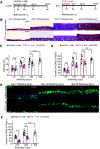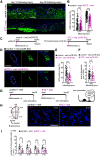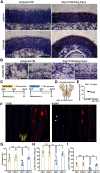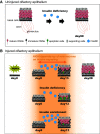Insulin-Dependent Maturation of Newly Generated Olfactory Sensory Neurons after Injury
- PMID: 33906971
- PMCID: PMC8143024
- DOI: 10.1523/ENEURO.0168-21.2021
Insulin-Dependent Maturation of Newly Generated Olfactory Sensory Neurons after Injury
Abstract
Loss of olfactory sensory neurons (OSNs) after injury to the olfactory epithelium (OE) triggers the generation of OSNs that are incorporated into olfactory circuits to restore olfactory sensory perception. This study addresses how insulin receptor-mediated signaling affects the functional recovery of OSNs after OE injury. Insulin levels were reduced in mice by ablating the pancreatic β cells via streptozotocin (STZ) injections. These STZ-induced diabetic and control mice were then intraperitoneally injected with the olfactotoxic drug methimazole to selectively ablate OSNs. The OE of diabetic and control mice regenerated similarly until day 14 after injury. Thereafter, the OE of diabetic mice contained fewer mature and more apoptotic OSNs than control mice. Functionally, diabetic mice showed reduced electro-olfactogram (EOG) responses and their olfactory bulbs (OBs) had fewer c-Fos-active cells following odor stimulation, as well as performed worse in an odor-guided task compared with control mice. Insulin administered intranasally during days 8-13 after injury was sufficient to rescue recovery of OSNs in diabetic mice compared with control levels, while insulin administration between days 1 and 6 did not. During this critical time window on days 8-13 after injury, insulin receptors are highly expressed and intranasal application of an insulin receptor antagonist inhibits regeneration. Furthermore, an insulin-enriched environment could facilitate regeneration even in non-diabetic mice. These results indicate that insulin facilitates the regeneration of OSNs after injury and suggest a critical stage during recovery (8-13 d after injury) during which the maturation of newly generated OSNs is highly dependent on and promoted by insulin.
Keywords: diabetes mellitus; electro-olfactogram; insulin; olfactory sensory neurons; regeneration; streptozotocin.
Copyright © 2021 Kuboki et al.
Figures











Similar articles
-
Structures and functions of the normal and injured human olfactory epithelium.Front Neural Circuits. 2024 Jun 6;18:1406218. doi: 10.3389/fncir.2024.1406218. eCollection 2024. Front Neural Circuits. 2024. PMID: 38903957 Free PMC article. Review.
-
Sensory deprivation disrupts homeostatic regeneration of newly generated olfactory sensory neurons after injury in adult mice.J Neurosci. 2015 Feb 11;35(6):2657-73. doi: 10.1523/JNEUROSCI.2484-14.2015. J Neurosci. 2015. PMID: 25673857 Free PMC article.
-
Protective Effect of Insulin in Mouse Nasal Mucus Against Olfactory Epithelium Injury.Front Neural Circuits. 2021 Dec 23;15:803769. doi: 10.3389/fncir.2021.803769. eCollection 2021. Front Neural Circuits. 2021. PMID: 35002636 Free PMC article.
-
Immature olfactory sensory neurons provide behaviourally relevant sensory input to the olfactory bulb.Nat Commun. 2022 Oct 19;13(1):6194. doi: 10.1038/s41467-022-33967-6. Nat Commun. 2022. PMID: 36261441 Free PMC article.
-
Olfactory receptor function.Handb Clin Neurol. 2019;164:67-78. doi: 10.1016/B978-0-444-63855-7.00005-8. Handb Clin Neurol. 2019. PMID: 31604564 Review.
Cited by
-
Sex steroid hormone synthesis, metabolism, and the effects on the mammalian olfactory system.Cell Tissue Res. 2023 Jan;391(1):19-42. doi: 10.1007/s00441-022-03707-9. Epub 2022 Nov 19. Cell Tissue Res. 2023. PMID: 36401093 Free PMC article. Review.
-
Are Multiple Chemosensory Systems Accountable for COVID-19 Outcome?J Clin Med. 2021 Nov 28;10(23):5601. doi: 10.3390/jcm10235601. J Clin Med. 2021. PMID: 34884303 Free PMC article. Review.
-
Sleep deprivation induces delayed regeneration of olfactory sensory neurons following injury.Front Neurosci. 2022 Dec 1;16:1029279. doi: 10.3389/fnins.2022.1029279. eCollection 2022. Front Neurosci. 2022. PMID: 36532269 Free PMC article.
-
Structures and functions of the normal and injured human olfactory epithelium.Front Neural Circuits. 2024 Jun 6;18:1406218. doi: 10.3389/fncir.2024.1406218. eCollection 2024. Front Neural Circuits. 2024. PMID: 38903957 Free PMC article. Review.
-
Aging and chronic inflammation: impacts on olfactory dysfunction-a comprehensive review.Cell Mol Life Sci. 2025 May 13;82(1):199. doi: 10.1007/s00018-025-05637-5. Cell Mol Life Sci. 2025. PMID: 40355677 Free PMC article. Review.
References
MeSH terms
Substances
Grants and funding
LinkOut - more resources
Full Text Sources
Other Literature Sources
Molecular Biology Databases
